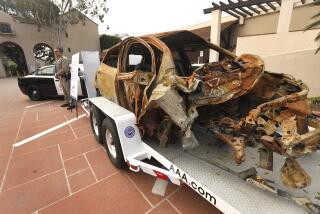Keep Alert for the Danger Signals of Drowsy Driving
- Share via
You’ve worked a full day, taken the dog to the kennel, gassed up the car, done your laundry and finished packing. Now you’re ready to hit the road and start your weekend getaway or vacation. You’ll drive well past midnight, but that’s no big deal.
This is a common getaway scenario. But here’s what may come as news to long-distance vacationers: Driving while sleep deprived can be just as dangerous as driving while drunk.
The National Highway Traffic Safety Administration estimates that 100,000 motor vehicle accidents reported to police annually involve driver drowsiness or fatigue as a principal cause. About 1,500 people a year die in these crashes, and 71,000 are injured.
Driving while drowsy is common. In a 1999 National Sleep Foundation poll, 62% of the respondents reported that in the prior year they had driven while feeling drowsy, 27% admitted to dozing off and 23% said they knew someone who had been in a fall-asleep crash.
In recent years, the drowsy driving problem has been gaining the attention of safety experts.
Even moderate sleep deprivation can impair driving. In a study conducted by Australia’s University of New South Wales and published last year in the journal Occupational and Environmental Medicine, 39 subjects were tested for memory, reaction time and other indicators after they had little sleep and again, when rested, after they had drunk alcoholic beverages. The researchers found that after 17 to 19 hours without sleep, performance on some tests was equal to or slower than when the subjects had a blood alcohol concentration of .05%. (In California, it is unlawful to drive with a blood alcohol concentration of .08% or more.) After longer periods without sleep, performance was equal to that of subjects who had a blood alcohol concentration of .1%.
Young people and shift workers who work a rotating schedule are most likely to be involved in drowsy driving crashes, according to the National Sleep Foundation.
Not surprisingly, driving on long, boring roads increases the chances of fatigue, as does driving alone.
What’s needed besides awareness of the problem is an attitude change, says Dr. Mark Mahowald of the Minnesota Regional Sleep Disorders Center. It’s socially acceptable to be sleep deprived, even kind of a status symbol, he says. Until people realize how dangerous sleep deprivation can be behind the wheel, drowsy driving accidents will continue to be a problem, he says.
Schools have initiated programs to make teen drivers aware of the risk, but the message often is contradicted by school policy. Mahowald notes that many high schools have “locked-up” proms or graduation parties to keep students away from alcohol, but let them drive home sleep deprived the next day.
Behind the wheel, you can progress quickly from drowsy to asleep, Mahowald says. “When you question people who had fall-asleep crashes, half did not believe they were sleepy.”
Worse, people rely on stay-awake measures that don’t always work. Most people open a window, turn on the air conditioner or turn up the radio. None of these should be relied on to keep you awake, Mahowald says.
What does work? Drinking caffeine, at least on a short-term basis, or pulling off the road to a safe place and napping for 15 to 45 minutes. Caffeine usually requires a half-hour to get into your bloodstream and give you a boost.
Stop every 100 miles or two hours to rest. Get a good night’s sleep the night before a long drive. Avoid over-the-counter medications when possible.
Know the signs of fatigue to avoid fall-asleep accidents, advise experts from the National Sleep Foundation. If you can’t remember the last few miles driven, if you find your thoughts wandering or you have difficulty focusing or keeping your head up, it’s time to pull off the road or switch drivers.
*
Healthy Traveler appears twice a month.






